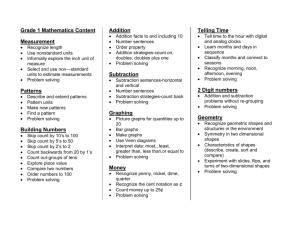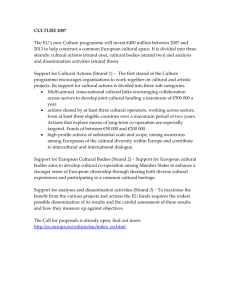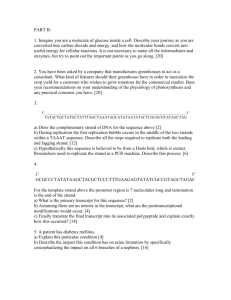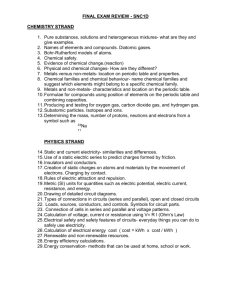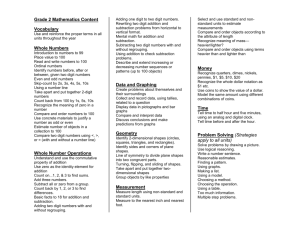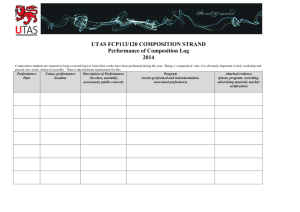Strand Unit ~Capacity
advertisement
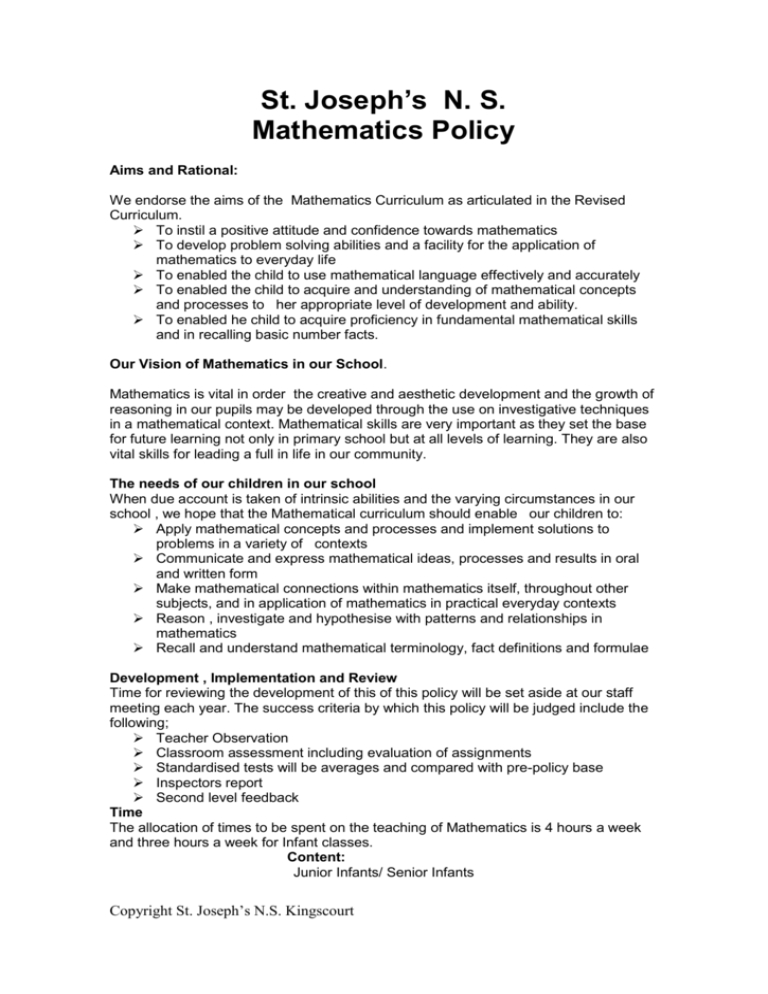
St. Joseph’s N. S.
Mathematics Policy
Aims and Rational:
We endorse the aims of the Mathematics Curriculum as articulated in the Revised
Curriculum.
To instil a positive attitude and confidence towards mathematics
To develop problem solving abilities and a facility for the application of
mathematics to everyday life
To enabled the child to use mathematical language effectively and accurately
To enabled the child to acquire and understanding of mathematical concepts
and processes to her appropriate level of development and ability.
To enabled he child to acquire proficiency in fundamental mathematical skills
and in recalling basic number facts.
Our Vision of Mathematics in our School.
Mathematics is vital in order the creative and aesthetic development and the growth of
reasoning in our pupils may be developed through the use on investigative techniques
in a mathematical context. Mathematical skills are very important as they set the base
for future learning not only in primary school but at all levels of learning. They are also
vital skills for leading a full in life in our community.
The needs of our children in our school
When due account is taken of intrinsic abilities and the varying circumstances in our
school , we hope that the Mathematical curriculum should enable our children to:
Apply mathematical concepts and processes and implement solutions to
problems in a variety of contexts
Communicate and express mathematical ideas, processes and results in oral
and written form
Make mathematical connections within mathematics itself, throughout other
subjects, and in application of mathematics in practical everyday contexts
Reason , investigate and hypothesise with patterns and relationships in
mathematics
Recall and understand mathematical terminology, fact definitions and formulae
Development , Implementation and Review
Time for reviewing the development of this of this policy will be set aside at our staff
meeting each year. The success criteria by which this policy will be judged include the
following;
Teacher Observation
Classroom assessment including evaluation of assignments
Standardised tests will be averages and compared with pre-policy base
Inspectors report
Second level feedback
Time
The allocation of times to be spent on the teaching of Mathematics is 4 hours a week
and three hours a week for Infant classes.
Content:
Junior Infants/ Senior Infants
Copyright St. Joseph’s N.S. Kingscourt
Strand: Early mathematical activities
Junior Infants
Strand Unit ~Classifying
The child should be enabled to
o Classify on the basis of one attribute such as colour, shape texture or size
o Identify the complement of a set
Strand Unit ~Matching
The child should be able to
o Match equivalent and non-equivalent sets using one-to–one correspondence
Strand Unit ~Comparing
The child should be able to
The child should be enabled to
o Compare objects to length, width, height, weight, quantity, thickness, or size
[long , longer]
o Compare sets without counting [ < ,>]
Strand Unit ~Ordering
The child should be enabled to
o Order objects according to length or height
o Order sets without counting
Strand: Number
Strand Unit ~Counting
Junior Infants
The child should be enabled to
o Count objects in a set, 1 – 10
[count regular rows then random groups: Use
number rhymes and stories]
Senior Infants
o Count the number of objects in a set 0- 20
Strand Unit ~Comparing and ordering
Junior Infants
The child should be enabled to
o Compare equivalent and non-equivalent sets 1 – 5 by matching without using
symbols [ more than , less than - using 1 to 1 correspondence to map equality
and inequality ]
o Ordering sets of objects by number 1-5
o Use the language or ordinal number [first,last]
Senior Infants
o Compare equivalent and non-equivalent set 1-10 [ name the inequality –I
have 2 more than you]
o Order sets of objects by number, 0-10
o Use the language of ordinal number; first second third
Strand Unit ~Analysis of Number
The child should be enabled to
Combining
Junior Infants
o Explore the components of numbers, 1- 5 [ 4 = 2+2 = {1+3= 3+1} related
facts -using concrete objects]
Copyright St. Joseph’s N.S. Kingscourt
o
o
o
Combine sets of objects, totals to 5 [ record pictorially
Senior Infants
Explore the components of number, 1-10
Combine sets of objects totals to 10 [ counting all, counting on, on number strip,
oral counting without number line
Partitioning
o
o
o
Junior Infants
Partition sets of objects 1-5 with a pencil to show component parts
Senior Infants
Partitioning sets of objects, 0-10 recording pictorially
Using symbols +,=to construct sentences involving addition
Numeration
o
o
o
o
o
o
o
o
o
o
Junior Infants
Develop an understanding of the conservation of number 1-5
Read, write and order numerals, 1-5
Identify the empty set and the numeral zero
Tell without counting the number of objects in a set, 1-5
Solve simple oral problems, 0-5
Senior Infants
Develop an understanding of the conservation of number 0-10
Read, write and order numerals, 0-10
Identify the empty set and the numeral zero
Estimate the number of objects in a set 2-10 [Check by counting]
Solve simple oral and pictorial problems, 0-10
Strand: Algebra
Strand Unit ~Extending patterns
Junior Infants
The child should be enabled to
Identify copy and extend patterns in colour, shape and size [ continue the pattern
:What comes next? Using cubes threading beads pegs paper shapes colours two sizes
]
o
o
o
Senior Infants
Identify, copy and extend patterns in colour, shape, size and number [ 3-4
elements]
Discover different arrays of the same number[ How many patterns of 10 can
you make?]
Recognise patterns and predict subsequent numbers [ 2,3,_,5,6,..]
Strand ~Shape and space
Strand Unit~ Spatial Awareness
Junior Infants
The child should be enabled to
o Explore, discuss, develop and use the vocabulary of spatial relations [ position;
over, under, on, down, beside… directions; moving in straight line curved line
in a circle
Copyright St. Joseph’s N.S. Kingscourt
Senior Infants
o Explore, discuss, develop and use the vocabulary of spatial relations
Strand Unit ~3-D shapes
Junior Infants
The child should be enabled to
o Sort 3-D shapes, regular and irregular [ roll , don’t roll….]
o Solve tasks and problem involving shape
Senior Infants
o Sort, describe and name 3-D shapes: cube, cuboid, sphere, cylinder
[ edge, corner, face, curved, round, flat]
o Combine 3-D shapes to make other shapes
o Solve tasks and problems involving shapes
Strand Unit ~2-D shapes
Junior Infants
The child should be enabled to
o Sort and name 2-D shapes: circle, square, rectangle, triangle [directed sorting
of 2-D shapes with different criteria]
o
o
o
o
o
o
Use suitable structured materials to create pictures
Solve problems involving shape [Which to shapes cover a square?]
Senior Infants
Sort and describe and name 2-D shapes
Combine and divide 2-D shapes to makes larger or smaller shapes
Solve problems involving shapes and space [Art]
Give simple moving and turning directions [P.E.]
Strand: Measures
Strand Unit ~Length
Junior Infants
The child should be enabled to
o Develop and understanding of the concept of length though exploration ,
handling of objects and use of appropriate vocabulary[short/long ;shorter/
longer]
o Compare objects according to length
Senior Infants
o Estimate and measure in non standard units [lollipop sticks]
Strand Unit ~Weight ~Junior Infants
The child should be enabled to
o Develop and understanding of the concept of weight though exploration ,
handling of objects and use of appropriate vocabulary [heavy/light; heavier/
lighter]
o Compare objects according to weight
Senior Infants
o Estimate and measure in non standard units [balance]
Strand Unit ~Capacity
Junior Infants
The child should be enabled to
o Develop and understanding of the concept of capacity though exploration and
the use of appropriate vocabulary
o Compare containers according to capacity
Senior Infants
o Compare and order containers according to capacity
o Estimate and measure capacity in non-standard units
Copyright St. Joseph’s N.S. Kingscourt
o
Select and use non-standard units to measure capacity
Strand Unit ~Time ~Junior Infants
The child should be enabled to
o Develop an understanding of the concept of time though the use of appropriate
vocabulary [ morning /evening/ days of the week]
o Sequence daily events of stages in a story
Senior Infants
o Read time in one hour intervals
Strand Unit ~Money
Junior Infants
The child should be enabled to
o Recognise and use coins up to 5 c
o Solve practical tasks and problems using money
Senior Infants
o Recognise coins up to 20c and use coins up to 10c
o Solve practical problems using money
Strand : Data
Strand Unit ~Recognising and interpreting data ~Junior Infants
The child should be enabled to
o Sort and classify sets of objects by one criterion [ basis of colour, shape ,
size….]
o Match sets equal and unequal [ enough/ more/ as much as.]
o Represent and interpret a set of simple mathematical data using real objects,
models and pictures
Senior Infants
o Sort and classify sets of objects by one and two criteria [ basis of colour, shape
, size….]
o Represent and interpret data in 2 rows or columns using real objects, models
and pictures
First/Second Class
Strand: Number
Strand Unit ~Counting and numeration
First Class
The child should be enabled to
o Count the number of objects in a set [regular and random array]
o Read write and order numerals, 0-99
o Estimate the number of objects in a set 0-20
Second Class
o Read, write and order numerals, 0-199
Strand Unit ~Comparing and ordering
The child should be enabled to
First Class
o Compare equivalent and non-equivalent sets 0-20 and name the inequality
o Order sets pf objects by number
o Use the language of ordinal number [1st-10th ]
Second Class
o Compare equivalent and non-equivalent sets using symbols ~ <>=
o Use the language of ordinal number using the calendar
Strand Unit ~ Place Value
The child should be enabled to
First Class
o Explore, identify and record place value 0 –99 T.U.
o Lollipop sticks cubes notation board base ten materials abacus pictorially]
Copyright St. Joseph’s N.S. Kingscourt
Second Class
Explore, identify and record place value 0 –199 H.T.U. [Lollipop sticks cubes
notation board base ten materials abacus pictorially]
Strand Unit ~Operations
Addition
The child should be enabled to
First Class
o Develop an understanding of addition by combining or partitioning sets and
using concrete materials 0-20
o Explore, develop and apply the communicative, associative and zero properties
of addition
o Develop and recall mental strategies for addition facts within 20
o Construct number sentences and stories : solve problems involving addition
within 20
o Add numbers without and with renaming within 99
o Explore and discuss repeated addition and group counting
Second Class
o Construct number sentences and stories: solve problems involving addition
within 99
o Explore and discuss repeated addition and group counting
Subtraction
First Class
o Develop an understanding of subtraction as deduction[ I had 10. I ate 3. I
have____ left?], as complementing [ I have 4 How many more to make a set of
10] and as difference I have 18 . You have 11 How many more have I?~ 0-20
o Develop and recall mental strategies for subtraction facts within 20
o Construct number sentences and stories : solve problems involving subtraction
within 20
o Estimate differences within 99
o Subtract numbers without renaming
o Use symbols +,-,=
o Solve one step problems involving addition or subtraction
o
o
o
o
Second Class
Subtract numbers with and without renaming within 99
Use symbols +,-,=,<,>
Solve one step and two step problems involving addition or subtraction
Strand Unit ~Fractions
The child should be enabled to
First Class
o Establish and identify half of sets to 20
Second Class
o Establish and identify halves and quarters of sets to 20
Strand: Algebra
The child should be enabled to
First Class
o Recognise pattern, including odd and even numbers
o Explore and use patterns in addition facts
o Understand and use a frame to show the presence of an unknown
number 2+ _ =12
Second Class
Recognise pattern and predict subsequent numbers [group counting ,
odd even numbers on 100 square
Copyright St. Joseph’s N.S. Kingscourt
o
Understand and use a frame to show the presence of an unknown
number 22 + 8 =__
2 + __+ 7 = 15
Strand ~Shape and space
Strand Unit~ Spatial Awareness
First Class
The child should be enabled to
o Explore, discuss, develop and use the vocabulary of spatial relations [ beneath,
between, on top of; through, left, right… closed shapes /open shapes]
o Give and follow simple directions within the classroom
Second Class
o Give and follow simple directions within the classroom and school setting
including turning directions using half turns and quarter turns
Strand Unit ~2-D shapes
First Class
The child should be enabled to
o Sort, describe, compare and name 2-D shapes: circle, square, rectangle,
triangle, semi circle [describe shapes referring to SIZE , corners, numbers and
length of sides ]
o Construct and draw 2-D shapes
o Combine and partition 2-D shapes
o Identify halves of 2-D shapes
o Identify 2-D shapes in the environment
Second Class
o Sort, describe, compare and name 2-D shapes: circle, square, rectangle,
triangle, semi circle, oval[ differences and similarities]
o Identify halves and quarters of 2-D shapes
Strand Unit ~3-D shapes
First Class/Second Class
The child should be enabled to
o Describe, compare and name
3-D shapes including cube , cuboid,
cylinder, sphere]
o Identify 2-D shapes in the environment
o Solve and complete practical tasks and problem involving 2-D /3-D shapes
o Explore the relationship between 2-D and 3-D shapes
Strand Unit ~Symmetry
Second Class
The child should be enabled to identify line symmetry in shapes and in
the environment [ Folding shapes in half, blob painting symmetrical objects]
Strand Unit ~Angles
Second Class
The child should be enabled to explore and recognise angles in the environment [
wheels , handles, corners right angle in card to measure angles]
Strand: Measures
Strand Unit ~Length
First Class
The child should be enabled to
o Estimate, measure and compare and record length using non standard units
[lollipop sticks, spans , strides, pencils]
o Select and use appropriate non-standard measuring units and instruments
o Estimate, measure and record length using standard unit ~metre [length,
height, measure, metre, nearly a metre, a bit more/less than a metre]
Copyright St. Joseph’s N.S. Kingscourt
o
Solve and complete practical tasks and problems involving length
Second Class
o Estimate, measure and record length using standard unit ~metre and
centimetre
Strand Unit ~Area ~ Second Class
The child should be enabled to
o Estimate, measure, record using non-standard units [cards, books copies,
cubes to cover the table]
Strand Unit ~Weight
First Class
The child should be enabled to
o Estimate, measure and compare and record weight using non standard units
[using weights and balance and by sight and feel]
o Select and use appropriate non-standard measuring units and instruments [
stones . cubes, beads to weigh school bag]
o Estimate, measure and record weight using standard unit ~Kilogram [, nearly a
kg, a bit more/less than a kg]
o Solve and complete practical tasks and problems involving weight
Second Class
o Estimate, measure and record length using standard unit ~kg ,
¼ kg, ½ kg
Strand Unit ~Capacity
First Class
The child should be enabled to
o Estimate, measure and compare and record capacity using non- standard units
[full, empty, hold more/less the same]
o Select and use appropriate non-standard measuring units and instruments
o Estimate, measure and record length using standard unit ~litre [ nearly a litre, a
bit more/less than a litre]
Second Class
o Estimate, measure and record length using standard unit ~Litre ½ litre . ¼ litre
o Compare containers according to capacity
Strand Unit ~Time
First Class
The child should be enabled to
o Use vocabulary associated with the sequence of time [ days of the week,
seasons, months of the year]
o Read and record times using simple devices[ and egg timer]
o Read time in one hour and half hour intervals on 12 hour analogue clock
o Read day, date and month using calendar
Second Class
o Read time in one hour and half hour intervals and ¼ hour on 12 hour analogue
clock
o Read time in one hour and half hour intervals on digital clock
o Read day, date and month using calendar and identify season
Strand Unit ~Money
First Class
The child should be enabled to
o Recognise exchange and use coins up to the value of 50 c
o Calculate how many items can be bought with a given sum
Second Class
o Recognise exchange and use coins up to the value of €2
Copyright St. Joseph’s N.S. Kingscourt
o
Write the value of a group of coins; record money amounts in cents and later as
euro 135c = $1.35
Strand : Data
Strand Unit ~Recognising and interpreting data
First Class
The child should be enabled to
o Sort and classify objects by two/ three criteria [ basis of colour, shape , size….]
o Represent and interpret data in two, three, four columns using real objects, and
pictures
Second Class
o Represent, read and interpret simple tables and charts [pictograms]
o Represent, read and interpret simple block graphs
************************************************************
Third/Fourth Class
Strand: Number
Strand Unit ~ Place Value
The child should be enabled to
Third Class
o Explore, identify and record place value 0 –999 H.T.U.
Using group swapping activities involving U.T.H. and lollipop sticks cubes notation
board base ten materials abacus pictorially]
o Read, write and order three-digit numbers
o Round whole numbers to the nearest ten of hundred
o Explore and identify place value in decimals numbers to one place of decimals
Fourth Class
o Explore, identify and record place value 0 –9999
Th. H.T.U.
Using group swapping activities involving U.T.H. and lollipop sticks cubes notation
board base ten materials abacus pictorially]
o Significance of zero 1078 2005 3620
o Read, write and order four digit numbers
o Round whole numbers to the nearest thousand
o Explore and identify place value in decimals numbers to two decimal places
Strand Unit ~Operations
Addition and subtraction
The child should be enabled to
Copyright St. Joseph’s N.S. Kingscourt
Third Class
o Add and subtract, without and with renaming, within 0-999
Estimate by rounding and adding
o Know and recall addition and subtraction facts
o Solve word problems involving addition and subtraction
Fourth Class
o Add and subtract, without and with renaming, within 0-9999
Estimate by rounding and adding : check with calculator
Multiplication~Third Class
o Explore , understand and apply the zero [5 x 0 = 0],communicative
[3 x 4 = 4 x 3 ]and distributive properties 5 x 4 = (3 x 4 )+( 2 x 4) , of multiplication
o Develop and recall multiplication facts within 100 [ Counting in sequence ;
multiplying doubles]
o Multiply 2 digits by 1 digit 6 x 28
o Solve and complete practical tasks and problems involving multiplication of
whole numbers
Fourth Class
o Multiply 2 digits or 3 digit number by a 1 or 2 digit number
o Estimate products and use a calculator to check
o Solve and complete practical tasks and problems involving multiplication of
whole numbers
Division
Third Class
o Develop an understanding of division as sharing and as repeated
subtraction with and without remainders
o Develop or recall division facts within 100 [Use inverse of x]
o Divide a 1 digit or 2-digit number by a 1 digit number with or without
remainders
o Record using division algorithm
o Solve and complete practical tasks and problems involving division of
whole numbers
Fourth Class
o Divide a 3 digit number by a 1 digit number without remainders and with
remainders and using regrouping
o Use calculators to check estimates
o Solve and complete practical tasks and problems involving division of
whole numbers
Strand Unit ~Fractions
The child should be enabled to
Third Class
o Identify fractions and equivalent forms of fractions with denominators
2,4,8 and 10 [Fraction Chart]
o Compare and order fractions with appropriate denominators and
position on the number line
o Calculate a fraction of a set using concrete materials
o Develop an understanding of the relationship between fractions and
division ~ ¼ of 32 = 8
o Calculate a unit fraction of a number and calculate a number, given
a unit fraction of the number
o Solve and complete practical tasks and problems involving fractions
Fourth Class
o Identify fractions and equivalent forms of fractions with denominators
2,3,4,5,6,8,9,10 and 12 [Fraction wall Chart]
Copyright St. Joseph’s N.S. Kingscourt
o
Calculate a number given a multiple fraction of the number 3/10 of a
number = 45.
o Express one number as a fraction of another number
3 = ½ of 6
o Solve and complete practical tasks and problems involving fractions
Strand Unit Decimals
The child should be enabled to
Third Class
o Identify tenths and express in decimal form [1/10 = 0.1 cutting
shapes into tenths using diagrams or chart
o Order decimals in the number line
o Solve problems using decimals
Fourth Class
o Express tenths and hundredths as fractions and decimals
o Identify place value of whole number and decimals to two places and write in
expanded form[ 3.45 = 3+ .0.4 + 0.05
o Add and subtract whole numbers and decimals up to tow places
o Multiply and divide a decimal up to two places by a single –digit whole number
o Solve problems involving decimals
Strand: Algebra
Strand Unit ; Number patterns and sequences
The child should be enabled to
Third Class
o Explore, recognise and record patterns in number 0- 999, groupings
of numbers and number bounds 17+3 ,27 + 3 Explore, extend and
describe sequences[ Explain rules]
o Use patterns as an aid for the memorisation of number facts
Fourth Class
o Explore, recognise and record patterns in number 0- 9999
Strand Unit : Number sentences ~3rd class
The child should be enabled to
o Translate an addition or subtraction number sentence with a
frame into a word problem
o Solve one stop number problems [400 - __ =350]
Fourth Class
o Translate an addition , subtraction, multiplication or division
number sentence with a frame into a word problem [ Frame not
in initial position
o Translate a one stop number problems [40= 8 x _]
Strand Unit ~Shape and space
Strand Unit ~2-D shapes
Third Class
The child should be enabled to
o Identify, describe, and classify 2-D shapes: circle, square, rectangle, triangle,
semicircle ,oval and irregular shapes
o Explore and describe their properties
o Construct and draw 2-D shapes
o Combine, tessellate and make patterns with 2-D shapes
o Solve and complete practical tasks and problems involving 2-D shapes
o Identify 2-D shapes in the environment
Fourth Class
Copyright St. Joseph’s N.S. Kingscourt
o
Identify, describe, and classify 2-D shapes: equilateral, isosceles and scalene
triangle. Parallelogram, rhombus, pentagon. octagon circle, square, rectangle,
triangle, semicircle ,oval and irregular shapes
Strand Unit ~3-D shapes
Third/ Fourth Class
The child should be enabled to
o Identify, describe, and classify 3-D shapes: cube, cuboid, Cylinder, cone.
sphere, triangular prism, pyramid
o Explore the relationship between 3-D with 2-D shapes
o Construct 3 D shapes [nets]
o Solve and complete practical tasks and problems involving 3-D shapes
Strand Unit ~Symmetry
Third Class
The child should be enabled to
o identify line symmetry in the environment
o Identify and draw lines of symmetry in two dimensional shapes
Fourth Class
o Identify lines of symmetry as horizontal, vertical or diagonal
o Use line symmetry to complete missing halves of shapes or patterns
Strand Unit ~Lines and Angles
Third Class
The child should be enabled to
o Identify, describe and classify vertical, horizontal and parallel lines
o Recognise and angle in terms of rotation
o Classify as greater than. Less than or equal to a right angle
o Solve problems involving lines and angles
Strand: Measures
Strand Unit ~Length
Third Class
The child should be enabled to
o Estimate, measure and compare and record length using the metric system
o Renames units of measurement in m and cm
o
Solve and complete practical tasks and problems involving addition and
subtraction of length
Fourth Class
o Renames units of length using decimal or fraction form
[ 25 cm = 0.25 =1/4 m
o Understanding, estimating and measure the perimeter of regular 2-D shapes
o Solve and complete practical tasks and problems involving addition and
subtraction , multiplication and division of units of length [m,cm, km]
Strand Unit ~Area ~ Third Class
The child should be enabled to
o Estimate, compare and measure the area of regular and irregular shapes[ nonstandard squared units]
Fourth class
o
Estimate, compare and measure the area of regular and irregular shapes[ sq. cm,
sq.m.]
Strand Unit ~Weight
Third Class
The child should be enabled to
o Estimate, measure and compare and record weight using metric units[kg,g]
Copyright St. Joseph’s N.S. Kingscourt
o
Solve and complete practical tasks involving addition and subtraction of kg., g.
Fourth Class
o Rename units in KG and g [2KG 300 g = 2300g ]
o Rename units in decimal or fraction form
o Solve and complete practical tasks involving addition and subtraction,
multiplication and division of kg., g.
Strand Unit ~Capacity
Third Class
The child should be enabled to
o Estimate, measure and compare and record capacity using standard metric
units [l. ml.]
o Solve and complete practical tasks involving addition and subtraction of l, ml.
Fourth Class
o Rename units of capacity in l and ml
o Rename units in decimal or fraction form
o Solve and complete practical tasks involving addition and subtraction,
multiplication and division of l.,ml..
Strand Unit ~Time
Third Class
The child should be enabled to
o Consolidate further a sense of time
o Read time in five-minute intervals on analogue and digital clocks
o Record time in on analogue and digital times
o Read and interpret simple timetables
o Rename minutes as hours and hours as minutes
o Read data form calendars and express weeks as days
o Solve and complete practical tasks and problems involving times and dates
Fourth Class
o Read time in one-minute intervals on analogue and digital clocks
o Solve and complete tasks and problems involving addition and subtraction of
hours and minutes
Strand Unit ~Money
Third Class
The child should be enabled to
o Renames amounts of euro or cents and record using symbols and decimals
point
o Solve and complete one-step problems involving the addition and subtraction of
money
Fourth Class
o Solve and complete tasks and problems involving addition and subtraction,
multiplication and division of money
Strand : Data
Strand Unit ~Recognising and interpreting data
Third Class
The child should be enabled to
o Collect, organise and represent data using pictograms, block graphs and bar
charts
o Read and interpret tables, pictograms, block graphs sand bar charts
o Use data to solve and complete tasks and problems
Fourth Class
o Collect, organise and represent data using pictograms, block graphs and bar
charts and bar line graphs incorporating the scales 1;2, 1;5, 1;10, 1;100
o Read and interpret bar-line graphs and simple pie charts using ½ , ¼ , 1/3
Copyright St. Joseph’s N.S. Kingscourt
Strand Unit ~ Chance
The child should be enabled to
o
o
o
Use vocabulary of uncertainty and chance [possible , impossible..]
Order events according to likelihood of occurring
Identify and record outcomes of simple random processes
**********************************************************
Content for fifth class and sixth class
Strand : Number
Strand Unit ~ Place Value
The child should be enabled to read, write and order numbers and decimals
{extend previous conceptual and practical work to include larger numbers and
decimals}
Identify place value in whole numbers and decimals
Round whole numbers and round decimals { round whole numbers to nearest
ten, hundred, thousand round decimals to nearest whole number}
Sixth class
Round decimals to one, two or three decimals places.
Strand Unit ~Operations
5th class
Estimate the differences, products and quotients of whole numbers { using
strategies for estimation e.g. front end estimation, rounding ,clustering, special
numbers, estimate calculations and compute answers with calculator}
Add and subtract whole numbers and decimals to 3 decimals places-develop
and extend the use of existing algorithms
Multiply a decimals [up to three places] by a whole number ,with or without a
calculator
Divide three-digit number by a two –digit number, without and with a calculator
[explore the concept of division with concrete materials, develop the long
division algorithm from repeated subtraction and multiples of repeated
subtraction}
divide a decimal number by a whole number ,without and with a calculator [
explore the concept of division of decimals with concrete materials –money and
measurement-extend the algorithm in conjunction with place value
Sixth Class
Multiply a decimal by a decimal with or without a calculator 7.25 x 1.55
Explore that multiplication does not always make larger –13.2 x 0.23
Divide a 4 digit number by a 2 digit number with or without calculator
Copyright St. Joseph’s N.S. Kingscourt
Divide a decimal number by a decimal number without and with a calculator
Explore that division does not always make smaller- 27.6/0.2
Strand Unit ~Fractions
5th class
Compare and order fractions and identify equivalent forms of fractions with
denominators 2-12 {explore, compare simple equivalence using concrete
materials paper folding and fraction charts
Express improper fractions and mixed numbers and visa versa and position
them on the number line
Establish equivalence by using concrete materials explore, compare and record simple
improper fractions and mixed numbers diagrammatically numerically and on the
number line
Add and subtract simple fractions and simple mixed numbers
Multiply a fraction by a whole number~ develop concepts with a concrete
materials paper folding and fraction charts -4 ¾ of a pizza is how many pizzas?
Express tenths, hundredths and thousandths in both fractional and decimal
form ~Explore and compare using concrete materials express as fractions and
as decimals
Sixth Class
Add and subtract simple fractions and simple mixed numbers using common
denominator
Multiply a fraction by a fraction- using concrete materials and diagrams and
leading to the development of and algorithm
Divide a whole number by a unit fraction 2/ ¼
Understand and use simple ratios - explore and record relationships between
natural numbers and their multiples
Strand Unit ~Decimals and percentages
5th Class
Develop an understand of simple percentages and relate then to fractions and
decimals ~ express percentages as fractions and as decimals and visa versa
Calculate simple percentages e.g. 50%, 25% 10%
Compare and order fractions and decimals ~Explore order and record using
concrete and money : order diagrammatically or on the number line
Solve problems involving operations with whole numbers ,fractions ,decimals
and simple percentages ~ use diagrams : estimate and compute answers with a
calculator include simple discount and increase examples 10% off jeans 20%
extra free
Sixth Class
Use percentages and relate them to fractions and decimals -Express
quantities as percentages
Compare and order percentages of numbers
Solve problems relating to profit and loss, discount, VAT, interest,
increases, decreases
Strand Unit ~Number theory
5th class
Identify simple prime and composite numbers
Define a prime number =a number greater than 1 with exactly 2 divisors itself and 1;
identify and record primes with Sieve of Eratosthenes ; define a composite number= a
number that has more than two divisors: identify and record composite numbers using
number facts; investigate relationships between odd and even numbers
Copyright St. Joseph’s N.S. Kingscourt
Identify square and rectangular numbers
{ construct diagrams on geoboards peg boards and squared paper to illustrate simple
square and rectangular numbers explore and compare numbers
Identify factors and multiples
Sixth Class
Identify and explore simple square roots –record and relate to square numbers
Write whole numbers in exponential form 1000 = 10 x 10 x 10 = 10 power 3
Strand : Algebra
Strand Unit ~Directed numbers
5th class
Identify positive and negative numbers in context
Examine and discuss money affairs video counters, calculator displays, sport reports,
golf .temperature: Refer to positive and negative numbers using signs + ,- label a
thermometer, weather around the world [Geography and nature}
Sixth Class
Add simple positive and negative numbers on the number line
– 5 + -7= _
Strand Unit ~ Rules and properties
Explore and discuss simple properties and rules about brackets and priority of
operation
Identify ,discuss and compute expressions with brackets in a variety of positions
10+[4+7]=
[10+4] +7 =
[8-1] +4=
8- [1+4]=
Discuss the significance of brackets? Establish the value of brackets, leading to the
priority of multiplication and division over addition and subtraction. BOMDAS
Brackets, of, multiplication, division addition subtraction
Identify relationships and record verbal and simple symbolic rules for number
patterns
Sequence increase 2, 3.5, 5.5, 7. Sequence decrease by dividing by 3
81,27,9,3………
Sixth Class Strand Unit ~ Variables
Explore the concept of a variable in the context of simple patterns , tables and
simple formulae and substitute values for variables e.g. D=2 X R
Substitute values into formulae and into symbolic rules developed from number
patterns
Strand Unit ~Equations
Translate number sentences with a frame into word problems and visa versa
Create number stories to describe a given number sentence “How many teams can
teacher make for relays from a class of 28 children 28/4 =7 : construct number
sentence to describe mathematically a given problem
Solve one step number sentence and equations 75-43=
3.5x - =14
25% of - =15
Sixth Class
Solve one step number sentence and equations -3 ++6 =_ : 10 x _ = 8 x
5
25% of - =15
Copyright St. Joseph’s N.S. Kingscourt
Strand Unit : Shape and Space
Strand Unit ~2-D Shapes 5th class
Make informal deductions about 2-D shapes and thief properties
Use angles and line properties to classify and describe triangles and
quadrilaterals
Identify the properties of a circle [ diameter radius counting square units]
Construct a circle of given radius or diameter
Tessellate combinations of 3 D Shapes
Classify 2-D shapes according to their lines of symmetry
Use 2 d shapes and properties to solve problems [ make a specified shape with
Tangram shapes
Sixth Class
Construct triangles from given sides and angles- given two angles and
the line between them or two side and an angle
Plot simple co-ordinates and apply where appropriate using squared
paper
Strand unit ~3-D shapes
Identify and examine
3-D shapes and explore relationships including
Tetrahedron [faces edges and vertices, shape of faces deconstruct 3 d
shapes into nets ; discuss
Draw the nets of simple 3d shapes from nets.
Integration Construction
Strand Unit ~Lines and angles
Recognise classify and describe angles and relate angles to shape and
the environment
Recognise angles in terms of rotation
Estimate measure and construct angles in degrees
Explore the sum of angles in a triangle [ cut three corners of a triangle
and put them together to make 180degrees; measure angles using
protractor : estimate angle sizes and check with protractor]
Sixth Class
Explore the sum of angles in a quadrilateral - [cut off the four corners of a paper
quadrilateral and put them together to make 360 degrees. Measure the angles using
protractor]
Strand :Measure
th
Strand Unit ~ Measure ~ 5 class
Select and use appropriate instrument of measurement [ruler /metre stick/
trundle wheel]
Estimate and measure length using appropriate metric units mm ~shorter
objects cm ~ longer objects m~ short distances
km ~ longer distances
Estimate and measure the perimeter of regular and irregular shapes
Sixth Class
Rename measures of length ; Express results as fractions or decimal of
appropriate metric units233m = 233/1000km = 0.233 km
Estimate and measure the perimeter of regular and irregular shapes
Use and interpret scales on maps and plans –identify given scale and draw
items to larger and smaller scale
Strand Unit ~ Area
Discover that the area of a rectangle is length by breadth
Estimate and measure the of regular and irregular 2 –D Shapes
Calculate area using centimetres squared and square metres
Copyright St. Joseph’s N.S. Kingscourt
Compare visually square metres and square centimetres.
Sixth Class
Recognise that the length of the perimeter of a rectangular shape does not
deter mine the area of the shape
Calculate the area of regular and irregular 2 d shapes
Measure the surface area of specified 3 d shapes [by extending the net]
Calculate area using Ares and hectares
Identify the relationship between square metres and square centimetres
Find the area of a room from a scale plan
Strand Unit ~Weight
5th class
Select and use appropriate instruments of measurement- kitchen scales
bathroom scales balance
Estimate and measure weight using appropriate metric units g kg
Sixth Class
Rename measures of weight using fractions or decimals of appropriate metric units
- 750 g = ¾ kg = 0.75 kg
4 kg 45 g = 4 45 /1000 = 4.045 kg
Strand Unit ~ Capacity
Select and use appropriate instruments of measurement –graduated jug
medicine spoon litre container
Estimate and measure capacity using appropriate metric units - ml litres
Sixth Class
Rename measures of capacity 625 ml = 5/8 l = 0.625 l
Find the volume of a cuboid experimentally – fill a cuboid container
with water and measure capacity in litres
Strand Unit ~Time
Read and interpret timetables and the 24 hour clock digital and
analogue
Interpret and convert between times on 12 hour and 24 hour format –
Sixth Class
Explore international time zones
Explore the relationship between time, distance and average speed
Strand Unit~ Money
The child should be enables to
Compare “Value for money” using unitary method 6 apples for 75c
and 4 apples for 50c ; calculate pay on hourly rate : totals of
shopping bills
Sixth Class
Explore value for money ~Calculate sale prices discounts VAT
Convert foreign currencies to euros and visa versa- discuss
exchange rates from newspapers
Strand : Data
Strand Unit ~ Representing and interpreting Data
Collect organise and represent data using pictograms single and
multiple bar charts and simple pie charts
Read and interpret pictograms , single and multiple bar charts and
pie charts- link with fractions and angles and Geography
Compile and use simple data sets –children’s height hobbies results
Explore and calculate averages of simple data
Use data sets to solve problems
Strand Unit ~Chance
Copyright St. Joseph’s N.S. Kingscourt
Identify and list all possible outcomes of simple random processes –
[rolling a dice 1,2,3,4,5,6, tossing a coin]
Estimate the likelihood of occurrence of events If we toss a coin 100
times heads tails 50; 100 1; 2 chance of occurring
Construct and use frequency charts and tables- data form coin
tossing and dice rolling Out come / frequency
Sixth class
o Estimate the likelihood of occurrence of events order on a scale
from 0 to 100 , 0 to 1
When tossing a coin, a head has I chance in 2 of occurring ; thus the
likelihood of a head is 1 in 2 or ½ or 50% ; similarly for a tail
When rolling a die , each outcome has a 1 in 6 chance of occurring
therefore the likelihood is 1/6 when drawing a cube from a bag
containing 3 red and 6 blue cubes, a blue cube has 6 chances in 9 of
occurring and thus has a probability of 6/9 or 2/3: the probability of
drawing a red cube is 3/9 or 1/3 :what if the bag contains 5 red 5 blue
and 5 green cubes/
Children with differing Needs
We aim to optimise teaching and learning process to enable pupils with learning difficulties to
achieve adequate levels of proficiency in mathematics before leaving school in order to full
participate in society. Where children are deemed to have difficulties their strengths and
weaknesses are further explored though diagnostic assessment. The importance of early
intervention in recognised and Learning support will be provided where possible for a child who
is having difficulty [See Learning Support Policy]
With regard to teaching pupils with low achievement the following guidelines are
recommended:
1. Group teaching
2. Modify presentation and questioning techniques to maximise the
involvement of pupils with low achievement in class activities
3. Setting up “buddy systems” – peer tutoring
Parents
Homework
Homework is used to support the mathematics programmes. Parental collaboration is
also encourages through inspection and checking of homework.
Resources
Unifix cubes
Lollipop sticks
Number lines
Counters
Interlocking cubes
Coloured teddies
Pegs and peg boards
Tops
100 squares
dice
Number games
Pre number Activities
shapes 2-D
shapes 3-D
Nets
Copyright St. Joseph’s N.S. Kingscourt
E-planning
Interactive Boards to be used as part of planning,
teaching and assessment
Maths Treasury
Amazing Maths
Number Shark
Penny Penguin
Sigma -T Assessments
Text books/ workbooks/Schemes
Review
This policy will be review on a yearly basis or any time when it is deemed
necessary
Copyright St. Joseph’s N.S. Kingscourt

